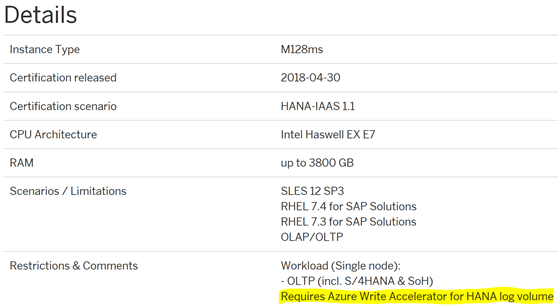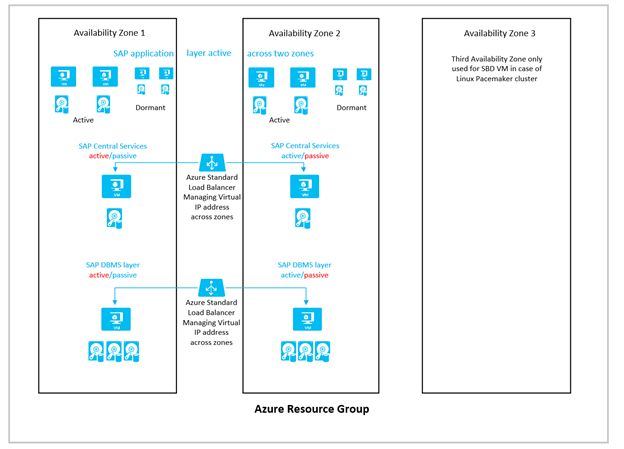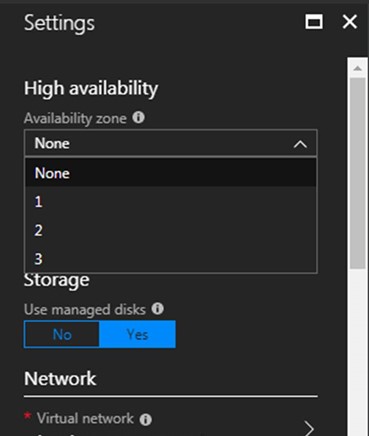SAP on Azure: General Update – June 2018
SAP and Microsoft are continuously adding new features and functionalities to the Azure platform. The key objective of the Azure cloud platform is to deliver the best performance and availability at the lowest TCO and simplest operation. This blog includes updates, fixes, enhancements and best practice recommendations collated over recent months.
1. M-Series is Certified for SAP Hana – S4, BW4, BWoH and SoH up to 3.8TB RAM
SAP Hana customers can run S4HANA, BW4Hana, BW on Hana and Business Suite on Hana in Production in many of the Azure datacenters in Americas, Europe and Asia. https://azure.microsoft.com/en-us/global-infrastructure/regions/ More information in this blog: https://azure.microsoft.com/en-us/blog/azure-m-series-vms-are-now-sap-hana-certified/
Requirements: Write Accelerator must be used for the Transaction Log disk only. Suse 12.3 or RHEL 7.3 or higher.
The SAP IaaS catalogue now includes M-series and Hana Large Instances


More information on the Write Accelerator can be found here:
https://azure.microsoft.com/en-us/blog/write-accelerator-for-m-series-virtual-machines-now-generally-available/ /en-us/azure/virtual-machines/windows/how-to-enable-write-accelerator
The central Note for SAP Hana on Azure VMs is Note 1928533 - SAP Applications on Azure: Supported Products and Azure VM types https://launchpad.support.sap.com/#/notes/0001928533
The Note for Hana Large Instances for memory up to 20TB scale up is Note 2316233 - SAP HANA on Microsoft Azure (Large Instances) https://launchpad.support.sap.com/#/notes/2316233
Summary of M-Series VMs for SAP NetWeaver and SAP Hana
M-Series running SAP Hana
1. Transaction Log disk(s) must have Azure Write Accelerator Enabled /en-us/azure/virtual-machines/linux/how-to-enable-write-accelerator
2. Azure Write Accelerator must not be activated on disks holding DBMS datafiles, temp files etc
3. Azure Accelerated Networking should always be enabled on M-Series VMs running Hana
4. The precise OS releases that are supported for Hana can be found in the SAP Hana IaaS Directory https://www.sap.com/dmc/exp/2014-09-02-hana-hardware/enEN/iaas.html#categories=Microsoft%20Azure
5. Where there is any discrepancy between any SAP OSS Note such as 1928533 or other source the SAP Hana IaaS Directory takes precedence
M-Series running AnyDB (SQL, Oracle, Sybase etc)
1. Windows 2012 2016, Suse 12.3, RH 7.x and Oracle Linux are all supported
2. Transaction Log disk(s) could have Azure Write Accelerator Enabled /en-us/azure/virtual-machines/linux/how-to-enable-write-accelerator
3. Azure Write Accelerator must not be activated on Data disks
4. Azure Accelerated Networking should always be enabled on M-Series VMs running AnyDB
5. If running Oracle Linux the RHEL kernel must be used as at June 2018 instead of Oracle UEK4 kernel. Oracle UEK5 will support Accelerated Networking with Oracle 7.5
Additional Small Certified M-Series VMs
Small M-Series VMs are certified:
1. M64ls with 64vCPU and 512GB
2. M32ls with 32vCPU and 256GB
3. M32ts with 32vCPU and 192GB
Disk configuration and additional information on these new smaller M-Series VMs can be found here /en-us/azure/virtual-machines/workloads/sap/hana-vm-operations
2. SAP NetWeaver on Windows Hyper-V 2016 Fully Supported
Windows Server 2016 Hyper-V is now fully supported as a Hypervisor for SAP applications running on Windows.
Hyper-V 2016 is a powerful component for customers wishing to deploy a hybrid cloud environment with some components on-premises and some components on Azure.
A special fix for Windows 2016 is required before using Hyper-V 2016. Apply the latest update for "Windows 10 1607/Windows Server 2016" but at least this patch level https://support.microsoft.com/en-us/help/4093120/windows-10-update-kb4093120 https://wiki.scn.sap.com/wiki/display/VIRTUALIZATION/SAP+on+Microsoft+Hyper-V
1409604 - Virtualization on Windows: Enhanced monitoring https://launchpad.support.sap.com/#/notes/0001409604
1409608 - Virtualization on Windows https://launchpad.support.sap.com/#/notes/0001409608
More information on Windows 2016 for SAP is here:
https://blogs.msdn.microsoft.com/saponsqlserver/2017/03/07/windows-2016-is-now-generally-available-for-sap/ https://blogs.sap.com/2017/05/06/performance-tuning-guidelines-for-windows-server-2016-hyper-v/
3. Build High Availability Capability within Azure Regions with Availability Zones
Availability Zones are Generally Available in many Azure Regions and are being deployed to most Azure regions shortly.
Availability Zones are physically separated datacenters with independent network and power infrastructure
VMs running in an Availability Zone achieve an SLA of 99.99% https://azure.microsoft.com/en-us/support/legal/sla/virtual-machines/v1_8/
A very good overview of Availability Zones on Azure and the interaction with other Azure components is detailed in this blog
https://blogs.msdn.microsoft.com/igorpag/2018/05/03/azure-availability-zones-quick-tour-and-guide/
More information below
/en-us/azure/load-balancer/load-balancer-standard-availability-zones https://blogs.msdn.microsoft.com/igorpag/2017/10/08/why-azure-availability-zones/ https://azure.microsoft.com/en-us/global-infrastructure/availability-zones/
A typical topology is depicted below.

The Azure Standard Internal Load Balancer is used for workloads that are distributed across Availability Zones. Even when deploying VMs into an Azure region that does not yet have Availability Zones it is recommended to use the Standard Internal Load Balancer in Zone-redundant mode. This allows
To view the VM types that are available in each Availability Zone in a Datacenter run this PowerShell command
Get-AzureRmComputeResourceSku | where {$_.Locations.Contains("southeastasia")-and $_.ResourceType.Equals("virtualMachines") -and $_.LocationInfo[0].Zones -ne $null }
Similar information can be seen in the Azure Portal when creating a VM

Customers building High Availability solutions with Suse 12.x operating system can review documentation on how to deploy single SID and Multi SID Suse Pacemaker clusters
The Microsoft documentation discusses the scenario "Microsoft SAP Fencing Agent + single iSCSI" STONITH configuration
An alternative deployment scenario "Two iSCSI devices in different Availability Zones".
A Suse bug fix may be required to configure two iSCSI devices:
https://www.suse.com/support/kb/doc/?id=7022477 https://ptf.suse.com/f2cf38b50ed714a8409693060195b235/sles12-sp3-hae/14410/x86_64/20171219 (a user id is needed)
A recommended deployment configuration is to place each iSCSI source in a different Availability Zone.
4. Sybase ASE 16.3 PL3 "Always-on" on Azure – 2 Node HA + 3rd Async Node for DR
A new blog with step-by-step instructions on how to install and configure a 2 node HA Sybase cluster with a third node for DR has been released.
https://blogs.msdn.microsoft.com/saponsqlserver/2018/05/18/installation-procedure-for-sybase-16-3-patch-level-3-always-on-dr-on-suse-12-3-recent-customer-proof-of-concept
5. Very Useful Links for SAP on Azure Consultants
The listing below is a comprehensive collection of links that has proved very useful for many consultants working at System Integrators.
SAP on Azure Reference Architectures
SAP S/4HANA for Linux Virtual Machines on Azure /en-gb/azure/architecture/reference-architectures/sap/sap-s4hana
Run SAP HANA on Azure Large Instances /en-gb/azure/architecture/reference-architectures/sap/hana-large-instances
Deploy SAP NetWeaver (Windows) for AnyDB on Azure Virtual Machines /en-gb/azure/architecture/reference-architectures/sap/sap-netweaver
High Availability SAP Netweaver Any DB
High-availability architecture and scenarios for SAP NetWeaver
Azure Virtual Machines high availability architecture and scenarios for SAP NetWeaver /en-us/azure/virtual-machines/workloads/sap/sap-high-availability-architecture-scenarios /en-us/azure/virtual-machines/workloads/sap/high-availability-guide-suse
Azure infrastructure preparation for SAP NetWeaver high-availability deployment
Prepare Azure infrastructure for SAP high availability by using a Windows failover cluster and shared disk for SAP ASCS/SCS instances /en-us/azure/virtual-machines/workloads/sap/sap-high-availability-infrastructure-wsfc-shared-disk
Prepare Azure infrastructure for SAP high availability by using a Windows failover cluster and file share for SAP ASCS/SCS instances /en-us/azure/virtual-machines/workloads/sap/sap-high-availability-infrastructure-wsfc-file-share
Prepare Azure infrastructure for SAP high availability by using a SUSE Linux Enterprise Server cluster framework for SAP ASCS/SCS instances https://docs.microsoft.com/en-us/azure/virtual-machines/workloads/sap/high-availability-guide-suse#setting-up-a-highly-available-nfs-server
Installation of an SAP NetWeaver high availability system in Azure
Install SAP NetWeaver high availability by using a Windows failover cluster and shared disk for SAP ASCS/SCS instances /en-us/azure/virtual-machines/workloads/sap/sap-high-availability-installation-wsfc-shared-disk
Install SAP NetWeaver high availability by using a Windows failover cluster and file share for SAP ASCS/SCS instances /en-us/azure/virtual-machines/workloads/sap/sap-high-availability-installation-wsfc-file-share
Install SAP NetWeaver high availability by using a SUSE Linux Enterprise Server cluster framework for SAP ASCS/SCS instances https://docs.microsoft.com/en-us/azure/virtual-machines/workloads/sap/high-availability-guide-suse#prepare-for-sap-netweaver-installation
High Availability SAP Hana
HANA Large Instance
SAP HANA Large Instances high availability and disaster recovery on Azure /en-us/azure/virtual-machines/workloads/sap/hana-overview-high-availability-disaster-recovery
High availability set up in SUSE using the STONITH /en-gb/azure/virtual-machines/workloads/sap/ha-setup-with-stonith
SAP HANA high availability for Azure virtual machines /en-gb/azure/virtual-machines/workloads/sap/sap-hana-availability-overview
SAP HANA availability within one Azure region /en-gb/azure/virtual-machines/workloads/sap/sap-hana-availability-one-region
SAP HANA availability across Azure regions /en-gb/azure/virtual-machines/workloads/sap/sap-hana-availability-across-regions
Disaster Recovery
Protect a multi-tier SAP NetWeaver application deployment by using Site Recovery /en-gb/azure/site-recovery/site-recovery-sap
SAP HANA Large Instances high availability and disaster recovery on Azure /en-gb/azure/virtual-machines/workloads/sap/hana-overview-high-availability-disaster-recovery
Setting Up Hana System Replication on Azure Hana Large Instances https://blogs.msdn.microsoft.com/saponsqlserver/2018/02/10/setting-up-hana-system-replication-on-azure-hana-large-instances/
Monitoring
New Azure PowerShell cmdlets for Azure Enhanced Monitoring https://blogs.msdn.microsoft.com/saponsqlserver/2016/05/16/new-azure-powershell-cmdlets-for-azure-enhanced-monitoring/
The Azure Monitoring Extension for SAP on Windows – Possible Error Codes and Their Solutions https://blogs.msdn.microsoft.com/saponsqlserver/2016/01/29/the-azure-monitoring-extension-for-sap-on-windows-possible-error-codes-and-their-solutions/
Azure Extended monitoring for SAP https://blogs.msdn.microsoft.com/saponsqlserver/2014/06/24/azure-extended-monitoring-for-sap/ /en-us/azure/operations-management-suite/ https://azure.microsoft.com/en-us/services/monitor/ https://azure.microsoft.com/en-us/services/network-watcher/
Automation
https://azure.microsoft.com/en-us/services/automation/
Automate the deployment of SAP HANA on Azure https://github.com/AzureCAT-GSI/SAP-HANA-ARM
Migration from on-premises DC to Azure
Transfer data with the AzCopy /en-us/azure/storage/common/storage-use-azcopy
Azure Import/Export service /en-us/azure/storage/common/storage-import-export-service
Very Large Database Migration to Azure https://blogs.msdn.microsoft.com/saponsqlserver/2018/04/10/very-large-database-migration-to-azure-recommendations-guidance-to-partners/
SAP on Azure - DMO with System Move https://blogs.sap.com/2017/10/05/your-sap-on-azure-part-2-dmo-with-system-move/
SAP on Azure certification
SAP Certified IaaS Platforms https://www.sap.com/dmc/exp/2014-09-02-hana-hardware/enEN/iaas.html#categories=Microsoft%20Azure
SAP Note #1928533 - SAP Applications on Azure: Supported Products and Azure VM types https://launchpad.support.sap.com/#/notes/1928533
SAP certifications and configurations running on Microsoft Azure /en-us/azure/virtual-machines/workloads/sap/sap-certifications
Azure M-series VMs are now SAP HANA certified https://azure.microsoft.com/en-us/blog/azure-m-series-vms-are-now-sap-hana-certified/
Backup Solutions
Azure VM backup for OS https://azure.microsoft.com/en-gb/services/backup/
HANA VM Backup – overview /en-us/azure/virtual-machines/workloads/sap/sap-hana-backup-guide
HANA VM backup to file /en-us/azure/virtual-machines/workloads/sap/sap-hana-backup-file-level
HANA VM backup based on storage snapshots /en-gb/azure/virtual-machines/workloads/sap/sap-hana-backup-storage-snapshots
HANA Large Instance (HLI) Backup – overview https://docs.microsoft.com/en-us/azure/virtual-machines/workloads/sap/hana-overview-high-availability-disaster-recovery#backup-and-restore
HLI backup based on storage snapshots https://docs.microsoft.com/en-us/azure/virtual-machines/workloads/sap/hana-overview-high-availability-disaster-recovery#using-storage-snapshots-of-sap-hana-on-azure-large-instances
Use third party backup tools: Commvault, Veritas, etc.
All the major third-party backup tools are supported in Azure and have agents for SAP HANA, SQL, Oracle, Sybase etc
Commvault
Azure: https://documentation.commvault.com/commvault/v11/article?p=31252.htm
SAP HANA: https://documentation.commvault.com/commvault/v11/article?p=22305.htm
Azure Marketplace: https://azuremarketplace.microsoft.com/en-us/marketplace/apps/commvault.commvault?tab=Overview
Veritas NetBackup
Azure: https://www.veritas.com/support/en_US/article.100041400
HANA: https://www.veritas.com/content/support/en_US/doc/16226696-127422304-0/v88504823-127422304
Azure Marketplace: https://azuremarketplace.microsoft.com/en-us/marketplace/apps/veritas.veritas-netbackup-8-s?tab=Overview
Security
Network
Logically segment subnets https://docs.microsoft.com/en-us/azure/security/azure-security-network-security-best-practices#logically-segment-subnets
Control routing behavior https://docs.microsoft.com/en-us/azure/security/azure-security-network-security-best-practices#control-routing-behavior
Enable Forced Tunneling https://docs.microsoft.com/en-us/azure/security/azure-security-network-security-best-practices#enable-forced-tunneling
Use virtual network appliances https://docs.microsoft.com/en-us/azure/security/azure-security-network-security-best-practices#use-virtual-network-appliances
Deploy DMZs for security zoning https://docs.microsoft.com/en-us/azure/security/azure-security-network-security-best-practices#deploy-dmzs-for-security-zoning
Avoid exposure to the Internet with dedicated WAN links https://docs.microsoft.com/en-us/azure/security/azure-security-network-security-best-practices#avoid-exposure-to-the-internet-with-dedicated-wan-links
Optimize uptime and performance https://docs.microsoft.com/en-us/azure/security/azure-security-network-security-best-practices#optimize-uptime-and-performance
HTTP-based Load Balancing https://docs.microsoft.com/en-us/azure/security/azure-security-network-security-best-practices#http-based-load-balancing
External Load Balancing https://docs.microsoft.com/en-us/azure/security/azure-security-network-security-best-practices#external-load-balancing
Internal Load Balancing https://docs.microsoft.com/en-us/azure/security/azure-security-network-security-best-practices#internal-load-balancing
Use global load balancing https://docs.microsoft.com/en-us/azure/security/azure-security-network-security-best-practices#use-global-load-balancing
Disable RDP/SSH Access to Azure Virtual Machines https://docs.microsoft.com/en-us/azure/security/azure-security-network-security-best-practices#disable-rdpssh-access-to-azure-virtual-machines
Enable Azure Security Center https://docs.microsoft.com/en-us/azure/security/azure-security-network-security-best-practices#enable-azure-security-center
Securely extend your datacenter into Azure https://docs.microsoft.com/en-us/azure/security/azure-security-network-security-best-practices#securely-extend-your-datacenter-into-azure
Operational
Monitor, manage, and protect cloud infrastructure https://docs.microsoft.com/en-us/azure/security/azure-operational-security-best-practices#monitor-manage-and-protect-cloud-infrastructure
Manage identity and implement single sign-on https://docs.microsoft.com/en-us/azure/security/azure-operational-security-best-practices#manage-identity-and-implement-single-sign-on
Trace requests, analyze usage trends, and diagnose issues https://docs.microsoft.com/en-us/azure/security/azure-operational-security-best-practices#trace-requests-analyze-usage-trends-and-diagnose-issues
Monitoring services https://docs.microsoft.com/en-us/azure/security/azure-operational-security-best-practices#monitoring-services
Prevent, detect, and respond to threats https://docs.microsoft.com/en-us/azure/security/azure-operational-security-best-practices#prevent-detect-and-respond-to-threats
End-to-end scenario-based network monitoring https://docs.microsoft.com/en-us/azure/security/azure-operational-security-best-practices#end-to-end-scenario-based-network-monitoring
Azure Security Center https://azure.microsoft.com/en-us/blog/protect-virtual-machines-across-different-subscriptions-with-azure-security-center/ https://azure.microsoft.com/en-us/blog/how-azure-security-center-helps-detect-attacks-against-your-linux-machines/
New VM Type for single tenant isolated VM https://azure.microsoft.com/en-us/blog/new-isolated-vm-sizes-now-available/
Azure Active Directory
Azure Active Directory integration with SAP HANA /en-us/azure/active-directory/active-directory-saas-saphana-tutorial?toc=/azure/virtual-machines/workloads/sap/toc.json
Azure Active Directory integration with SAP Cloud Platform Identity Authentication /en-us/azure/active-directory/active-directory-saas-sap-hana-cloud-platform-identity-authentication-tutorial?toc=/azure/virtual-machines/workloads/sap/toc.json
Azure Active Directory integration with SAP Business ByDesign /en-us/azure/active-directory/active-directory-saas-sapbusinessbydesign-tutorial?toc=/azure/virtual-machines/workloads/sap/toc.json
Azure Active Directory integration with SAP Cloud for Customer for SSO functionality https://blogs.sap.com/2017/08/02/azure-active-directory-integration-with-sap-cloud-for-customer-for-sso-functionality/
S/4HANA environment – Fiori Launchpad SAML Single Sign-On with Azure AD https://blogs.sap.com/2017/02/20/your-s4hana-environment-part-7-fiori-launchpad-saml-single-sing-on-with-azure-ad/
Very good rollup article on Azure Networking https://blogs.msdn.microsoft.com/igorpag/2017/04/06/my-personal-azure-faq-on-azure-networking-v3/
Special thanks to Ravi Alwani for collating these links
6. New Microsoft Features for SAP Customers
Microsoft has released many new features for SAP customers:
Azure Site Recovery Azure-2-Azure – Support for Suse 12.x has been released! /en-us/azure/site-recovery/azure-to-azure-support-matrix
Global vNet Peering – previously it was not possible to Peer vNets from other datacenters. This is now Generally Available in some datacenters and is being deployed globally. One of the biggest advantages of Global vNet Peering is that network traffic will be carried across the Azure network backbone.
https://blogs.msdn.microsoft.com/wushuai/2018/02/04/provide-cross-region-low-latency-service-based-on-azure-vnet-peering/ https://azure.microsoft.com/en-us/blog/global-vnet-peering-now-generally-available/
The new Standard Internal Load Balancer (ILB) is Availability Zone aware and has better performance than the regular Basic ILB
https://docs.microsoft.com/en-us/azure/azure-subscription-service-limits#load-balancer https://github.com/yinghli/azure-vm-network-performance (scroll down to review performance)
SQL Server 2016 Service Pack 2 (SP2) released https://blogs.msdn.microsoft.com/sqlreleaseservices/sql-server-2016-service-pack-2-sp2-released/
Linux customers are recommended to setup Azure Serial Console. This allows access to a Linux VM when the network stack is not working. This feature is the equivalent of an RS-232/COM port cable connection /en-us/azure/virtual-machines/linux/serial-console
Azure Storage Explorer provides easier management of blob objects such as backups on Azure blob storage https://azure.microsoft.com/en-us/features/storage-explorer/
Azure now offers Trusted Execution Environment leveraging Intel Xeon Processors with Intel SGX technology. So far this is not tested with SAP yet, but may be validated in the future https://azure.microsoft.com/en-us/blog/azure-confidential-computing/
More information on new Network features can be found here https://azure.microsoft.com/en-us/blog/azure-networking-may-2018-announcements/ https://azure.microsoft.com/en-us/blog/monitor-microsoft-peering-in-expressroute-with-network-performance-monitor-public-preview/
7. New SAP Features
SAP has released a new version of SWPM. It is recommended to use this version for all new Installations. The tool can be downloaded from https://support.sap.com/en/tools/software-logistics-tools.html
1680045 - Release Note for Software Provisioning Manager 1.0 (recommended: SWPM 1.0 SP 23) https://launchpad.support.sap.com/#/notes/0001680045
Customers interested in automating SWPM can review 2230669 - System Provisioning Using a Parameter Input File https://launchpad.support.sap.com/#/notes/2230669
SAP has released new SAP Downwards Compatible Kernels. SAP has provided guidance to switch to using the new 7.53 kernel for all new Installations:
SAP recommends using the latest SP stack kernel (SAPEXE.SAR and SAPEXEDB.SAR), available in the Support Packages & Patches section of the SAP Support Portal https://launchpad.support.sap.com/#/softwarecenter.
For existing installations of NetWeaver 7.40, 7.50 and AS ABAP 7.51 this is SAP Kernel 749 PL 500. For details, see release note 2626990.
For new installations of NetWeaver 7.40, 7.50 and AS ABAP 7.51 this is SAP Kernel 753 PL 100. For details, see DCK note 2556153 and release note 2608318.
For AS ABAP 7.52 this is SAP Kernel 753 PL 100. For details, see release note 2608318.
2083594 - SAP Kernel 740, 741, 742, 745, 749 and 753: Versions and Kernel Patch Levels https://launchpad.support.sap.com/#/notes/2083594
2556153 - Using kernel 7.53 instead of kernel 7.40, 7.41, 7.42, 7.45, or 7.49 https://launchpad.support.sap.com/#/notes/0002556153
2350788 - Using kernel 7.49 instead of kernel 7.40, 7.41, 7.42 or 7.45 https://launchpad.support.sap.com/#/notes/0002350788
1969546 - Release Roadmap for Kernel 74x and 75x https://launchpad.support.sap.com/#/notes/1969546 https://wiki.scn.sap.com/wiki/display/SI/SAP+Kernel:+Important+News
8. Recommended Hana on Azure Disk Design Template
The Excel spreadsheet HANA-Disk-Design-Template-for-Azure contains a useful model template for customers planning to deploy Hana on Azure VMs.
The spreadsheet contains a sample Hana deployment on Azure M-series with details such as stripe sizes, Write Accelerator and other useful configuration settings
Further information and details can be found in the Azure documentation here: /en-us/azure/virtual-machines/workloads/sap/hana-vm-operations
The spreadsheet is a sample only and should be adapted as required, for example the Availability Zone column will likely need to be updated.
Special thanks to Archana from Cognizant for creating this template
9. Disable 8.3 Filename Generation
Very old Windows releases were limited to filenames of 8.3 characters. Some applications that call very old file handling APIs can only reference files by their 8.3 format filenames.
Up to and including Windows Server 2016 all files with more than 8.3 characters will have a 8.3 format filename created.
This operation becomes very expensive if there are very large numbers of files in a directory. Frequently SAP customers will keep job logs or interface files on the /sapmnt share and the total number of files can reach hundreds of thousands.
It is recommended to disable 8.3 filename generation on all existing Windows servers and to include disabling 8.3 filename generation as part of the standard build of new Windows servers alongside steps such as removing Internet Explorer and disabling SMB v1.0.
662452 - Poor file system performance/errors during data accesses https://launchpad.support.sap.com/#/notes/662452

10. Hundreds of vCPU and 12TB Azure VMs Certified for SAP Hana Announced
In a blog by Corey Sanders Microsoft confirms a new generation of M-Series VMs supporting hundreds of vCPU and 12TB of RAM. The blog "Why you should bet on Azure for your infrastructure needs, today and in the future" announces the following:
1. Next Generation M-Series based on Intel Skylake CPU supporting up to 12TB of RAM
2. New Hana Large Instance TDIv5 appliances 6 TB, 12 TB and 18 TB
3. New Standard SSD based storage – suitable for backups and bulk storage https://azure.microsoft.com/en-us/blog/preview-standard-ssd-disks-for-azure-virtual-machine-workloads/
4. New smaller M-Series VMs suitable for non-production, Solution Manager and other smaller SAP Hana databases
https://azure.microsoft.com/en-us/blog/why-you-should-bet-on-azure-for-your-infrastructure-needs-today-and-in-the-future/ https://azure.microsoft.com/en-us/blog/offering-the-largest-scale-and-broadest-choice-for-sap-hana-in-the-cloud/
Miscellaneous Topics, Notes & Links
2343511 - Microsoft Azure connector for SAP Landscape Management (LaMa) https://launchpad.support.sap.com/#/notes/0002343511
Optimizing SAP for Azure https://www.microsoft.com/en-us/download/details.aspx?id=56819
Useful link on setting up LVM on Linux VMs /en-us/azure/virtual-machines/linux/configure-lvm
Updated SQL Column Store documentation – recommended for all BW on SQL customers 2116639 - SQL Server Columnstore Documentation https://launchpad.support.sap.com/#/notes/0002116639